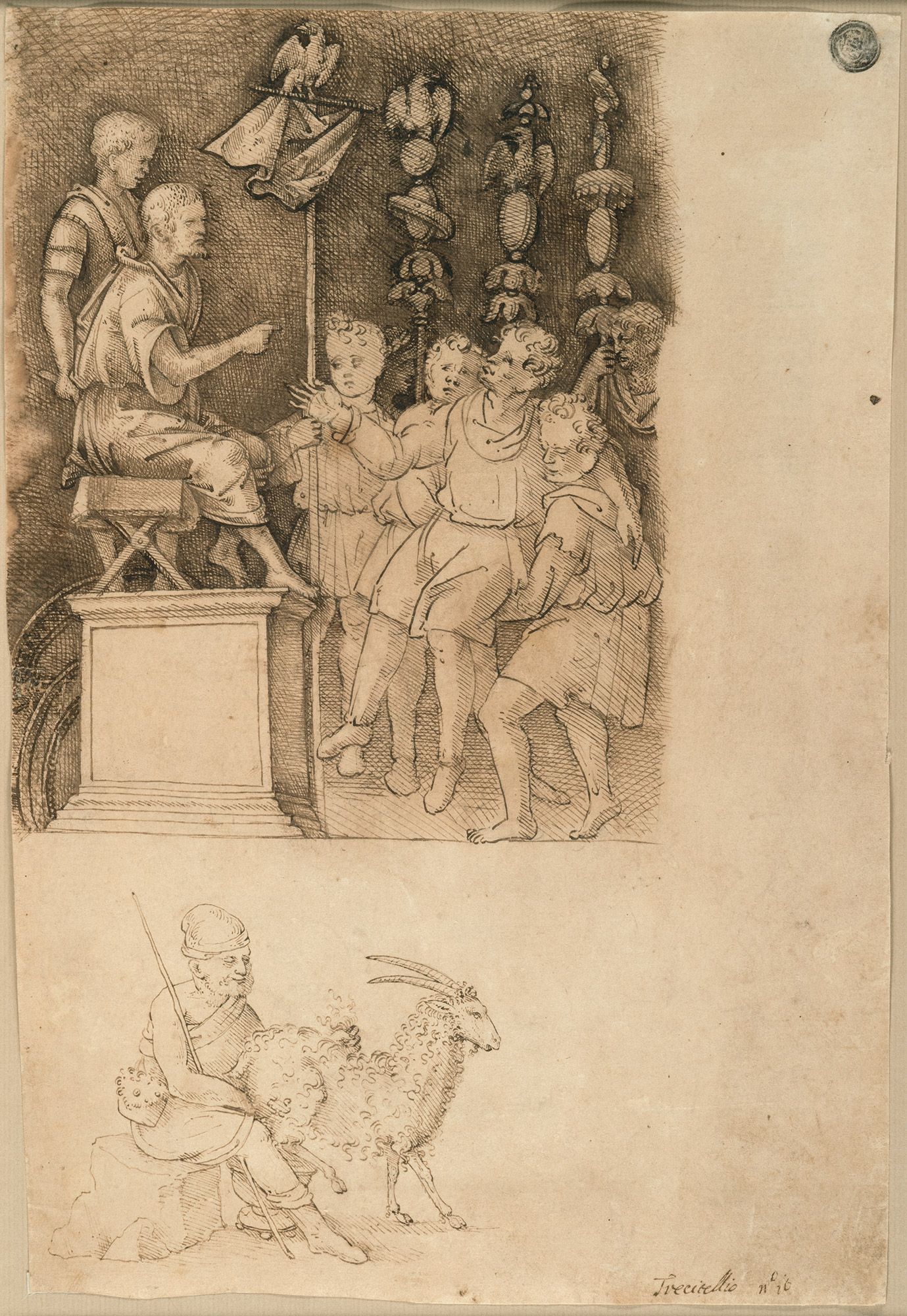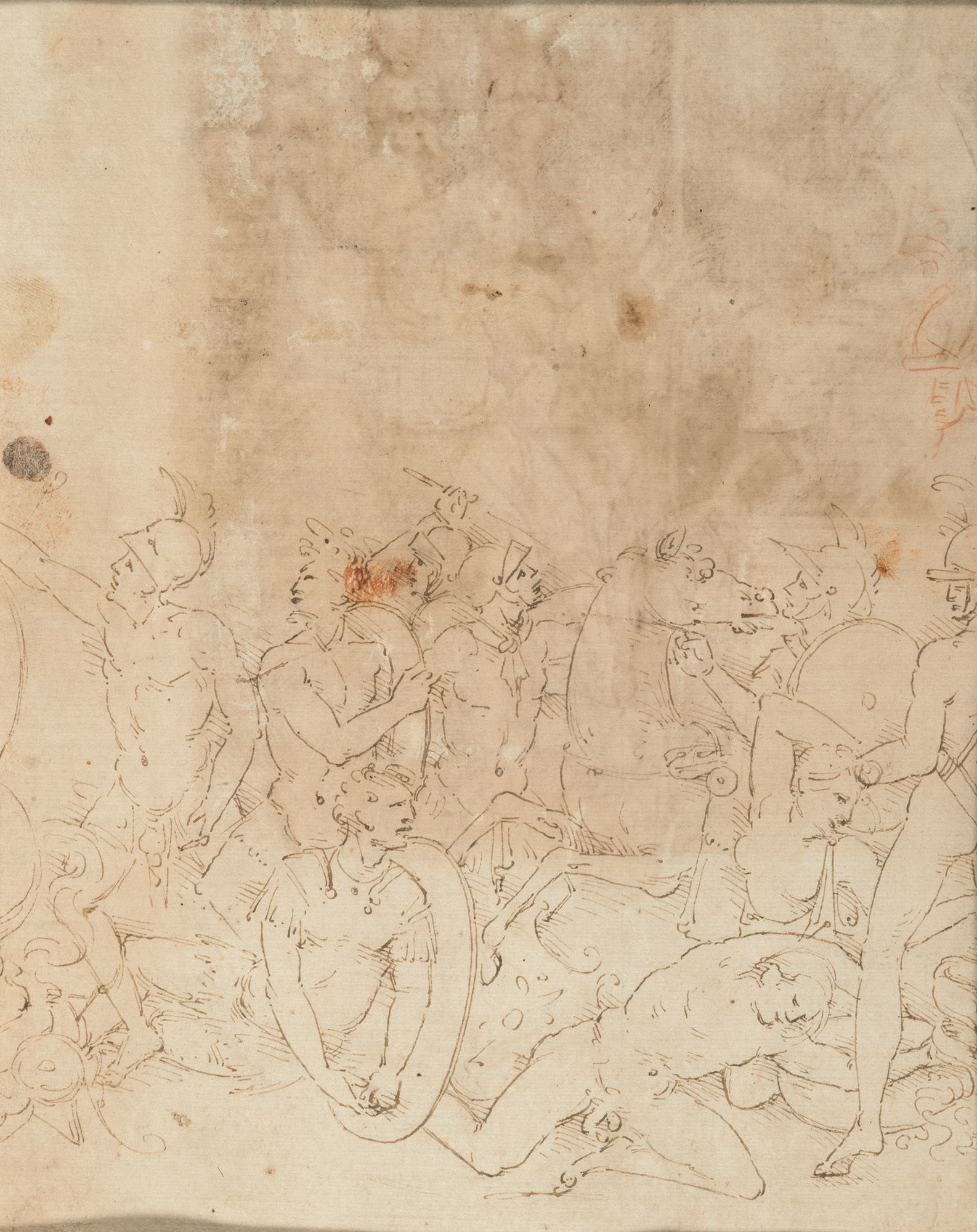FJK 001
Aspertini Amico (Italian, Bologna ca. 1474–1552 Bologna)
Study after the Old Masters (recto)
Battle Scene (verso)
ca. 1500
14 61/64 × 10-10 23/64 in. (380 × 254-263 mm)
Medium
Pen and brown ink on traces of black chalk (recto)
Pen, brown ink and a subsidiary head in red chalk drawned by another hand? (verso)
Old inscription bottom right: Trecitellio no 16
Stamp from an unknown collection at upper right: coat of arms or “C”
Origin
Earl of Beauchamp Collection (until 1973)
Sale, Sotheby’s, London, July 9, 1973, no. 2
Paul Drey Collection, New York
Jan Krugier Collection, Monaco (acquired from previous owner in May 1983), JK 3724
Jan Krugier Foundation
Bibliography
SCHMITT Annegrit, Staatliche Graphishe Sammlung, Berlin, letter to Mrs. Mme Paul Drey, November 1973 (London).
COSMO G., “Aspertini e la scultura antica” in Antologia di Belle Arti, 21-22, 1984, p. 30, ill. under artist in the circle of Aspertini, possibly a pupil.
BOBER P.P. and RUBINSTEIN R., Renaissance Artists and Antique Sculpture. A Handbook of Sources, London/Oxford, 1986, p. 195, no. 162.
SCHWEIKHART G., Der Codex Wolfegg. Zeichnungen nach der Antique von Amico Aspertini, London, 1986, p. 66, 106, ill.
FAIETTI Marzia, and OBERHUBER Konrad, Humanismus in Bologna 1490-1510, exh. cat. Vienna, Graphische Sammlung Albertina, 1988, Bologna: Nuova Alfa Editoriale, 1988 p. 219, ill. 1, text by Daniela Scaglietti, pp. 281f.
RUGGERI U., Disegni veneti i lombardi dal XVI al XVIII secolo. Dalle Collezioni del Gabinetto dei Disegni e delle Stampe, Rome, Istituto Nazionale per la Grafica, 1989, p. 151.
SCHWEIKHART G., “Studio e reinvenzione dell'Antico nell'opera di Amico Aspertini,” in Silvia Danesi Squarzina ed., Roma, centro ideale della cultura dell'Antico nei secoli XV e XVI, Da Martino V al Sacco di Rome 1417-1527, Milan, 1989, p. 401 (under Aspertini or in the circle of Aspertini).
FAIETTI Marzia, Amico Aspertini, Anna Stanzini ed., Il restauro, intelligenza e progetto. Dalla ricostruzione ad oggi. Il decennio 1978-1988, Bologna, 1990, p. 71, no. 2; p. 73, no. 2.
FAIETTI Marzia, “New Drawings by Amico Aspertini,” in Master Drawings, vol. 29, no. 2, New York, 1991, pp. 149, 153; fig. 16 (ill. of the reverse).
VON KÜGELGEN H., “Artikel Aspertini Amico,” Saur, Allgemeines Künstler-Lexicon. Die Bildenden Künstler aller Zeiten und Völker, vol. 5, Munich/Leipzig, 1992, p. 443.
FAIETTI Marzia, SCAGLIETTI KELESCIAN D., Amico Aspertini, Modène, 1995, pp. 28f, 233f, no. 16, ill.
Exhibitions
Berlin, Kupferstichkabinett, Staatliche Museen zu Berlin, Linie, Licht und Schatten. Meisterzeichnungen und Skulpturen der Sammlung Jan und Marie-Anne Krugier-Poniatowski, exh. cat., 1999, pp. 32-34, no. 10, color ill. pp. 33, 35.
Venice, Peggy Guggenheim Collection, Solomon R. Guggenheim Foundation, The Timeless Eye. Master Drawings from the Jan and Marie-Anne Krugier-Poniatowski Collection, exh. cat., 1999, pp. 38-40, no. 13, color ill. pp. 39, 41.
Madrid, Museo Thyssen-Bornemisza, Miradas sin Tiempo. Dibujos, Pinturas y Esculturas de la Coleccion Jan y Marie-Anne Krugier-Poniatowski, exh. cat., 2000, pp. 60-62, no. 16, color ill. pp. 61, 63.
Paris, Musée Jacquemart-André, La passion du dessin. Collection Jan et Marie-Anne Krugier-Poniatowski, exh. cat., 2002, p. 58, no. 18, color ill. p. 59.
Munich, Kunsthalle der Hypo-Kulturstiftung, Das Ewige Auge - Von Rembrandt bis Picasso. Meisterwerke aus der Sammlung Jan Krugier und Marie-Anne Krugier-Poniatowski,exh. cat., 2007, p. 40, no. 12, color ill. p. 41.
Notes
Notes (1)
A German Prisoner being brought before Marcus Aurelius(recto) is a study after a relief on the arch of Constantine of which a rather faithful copy is in the Ripanda Codex in Oxford. On this drawing, Aspertini has altered, as he did quite often, some of the antique models. For instance, he changed the old bearded men into young boys.
The Shepherd with a Goat(recto) was repeated by Aspertini in the Wolfegg Codex. The model was an antique relief which at Aspertini's time was in Santi Apostoli, Rome.
[Battle Scene](verso) is derived, with strong variations, from part of the Sarcophagus of the Amazons which today is in the German Archaeological Institute in Rome, and which in Aspertini's time was in San Gregorio, Rome. Aspertini included the design of the whole front of the Sarcophagus, again with variations, in the Wolfegg Codex.
According to a letter of November 1973 by Dr. Annegrit Schmitt, co-author of the Corpus der Italienischen Zeichnungen 1300-1450
Notes (2)
Aspertini’s drawings are generally studies after artworks, especially antique sculpture encountered during his travels. Since Cosmo’s publication, the sheet from the Jan Krugier Foundation is unanimously considered to be by the hand of the artist, and one of the most important works for what it reveals of the famous codex of the counts Waldburg von Wolfegg.
It certainly belonged to an album, out of which only three or four sheets survived. One of them, sold at auction in 1973 and preserved at the Baltimore Museum of Art, carries a similar inscription. The latter appears on two other sheets preserved at The Metropolitan Museum of Art and at the Pierpont Morgan Library. Finally, the unlisted collector’s mark is found on another sheet at the British Library.
The same battle scene illustrates folios 25-26 of the Wolfegg codex and the verso of the present sheet, which all present a similar composition. The model was a sarcophagus representing Amazons which used to be in Rome, today at the Antikensammlung in Berlin (Acc. no. SK 1878, fig. 13).
For the recto, as is customary for Aspertini, he was inspired by an Antonine relief from the Arch of Constantine, without literally copying it. He removed some of the marginal figures, the soldiers’ faces have become glabrous, and the German chief is floating in the air to accentuate the precariousness of his situation.
The Wolfegg codex informs us about the shepherd and the goat, both inspired by a Bacchic antique scene, perhaps located near Santi Apostoli according to an inscription. While the recto shows brilliant use of hatchings, the verso is closer to Aspertini’s idealization, mixing different drawing techniques.
These sheets would date from Aspertini’s first trip to Rome, around 1496-1503. As indicated by Faietti, although Aspertini was ambidextrous, he executed this drawing exclusively with his left hand. Finally, a study of a similar low-relief with close figures can be seen in the Adoration of the Shepherds(ca. 1500), preserved at the Gemälde Gallery in Berlin.
Weniger Matthias, La Passion du Dessin, Paris, Musée Jacquemart-André, 2002, p. 58 (translated from French)
Request for information/loan
The Jan Krugier Foundation is devoted to increasing the impact of the collection of drawings through regular loans to major exhibitions. Loan applications should include a complete presentation of the project.


